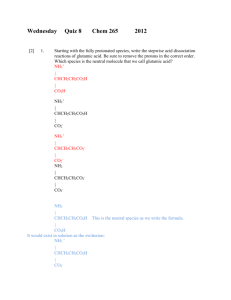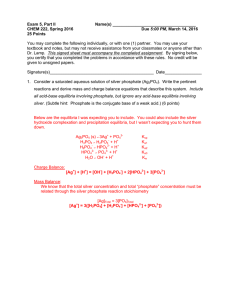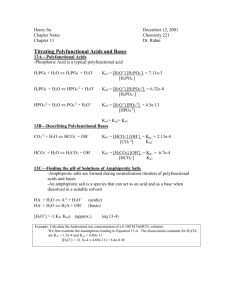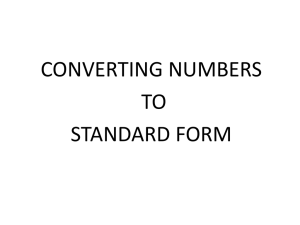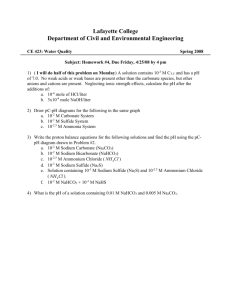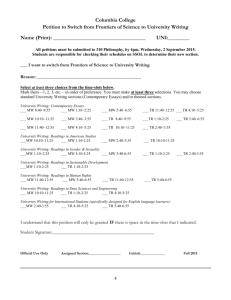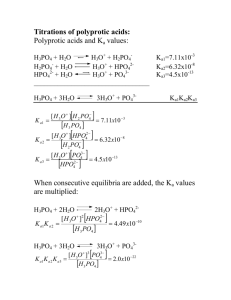Lec 19 - An
advertisement
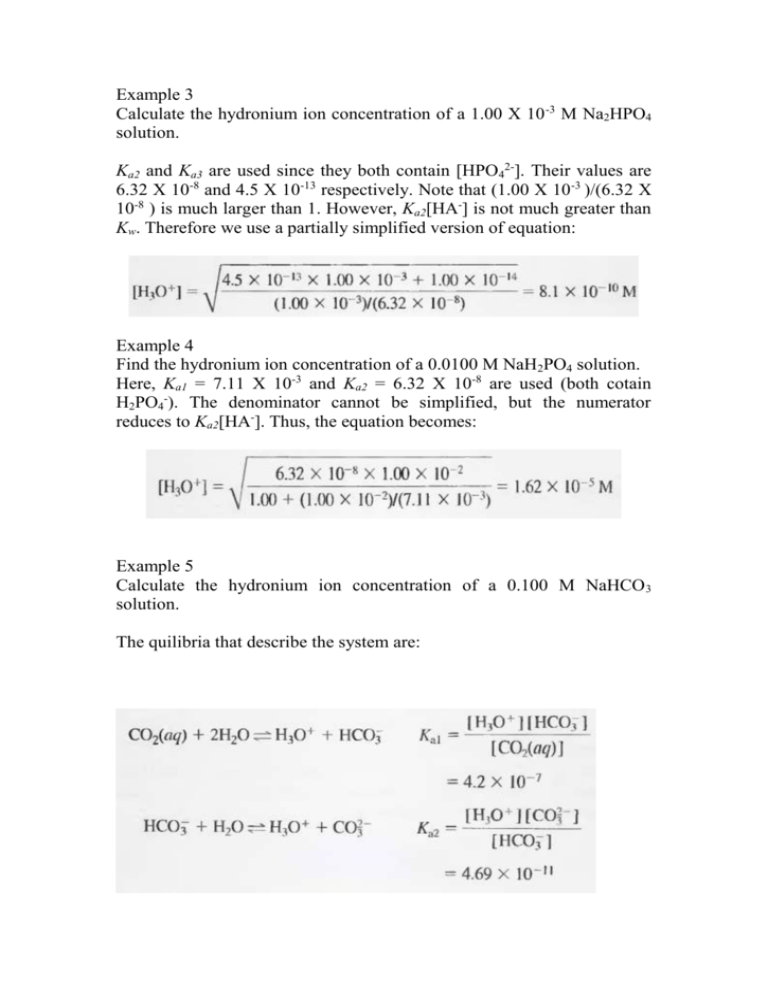
Example 3 Calculate the hydronium ion concentration of a 1.00 X 10 -3 M Na2HPO4 solution. Ka2 and Ka3 are used since they both contain [HPO42-]. Their values are 6.32 X 10-8 and 4.5 X 10-13 respectively. Note that (1.00 X 10-3 )/(6.32 X 10-8 ) is much larger than 1. However, Ka2[HA-] is not much greater than Kw. Therefore we use a partially simplified version of equation: Example 4 Find the hydronium ion concentration of a 0.0100 M NaH2PO4 solution. Here, Ka1 = 7.11 X 10-3 and Ka2 = 6.32 X 10-8 are used (both cotain H2PO4-). The denominator cannot be simplified, but the numerator reduces to Ka2[HA-]. Thus, the equation becomes: Example 5 Calculate the hydronium ion concentration of a 0.100 M NaHCO 3 solution. The quilibria that describe the system are: [HA-]/Kal is much larger than unity; in addition, Ka2 [HA-] has a value of 4.69 X 10-12, which is much greater than Kw. Therefore; [H3O+] = (4.2 X 10-7 X 4.69 X 10-11)1/2 = 4.4 X 10-9 M Titration Curves for Polyfunctional Acids: Accurate theoretical titration curves for polyprotic acids can be obtained if the ratio Ka1/Ka2 is somewhat greater than 103. The next figure shows the titration curve for a diprotic acid, H2A with Kal = 1.00 X 10-3 and Ka2 = 1.00 X 10-7. For initial pH (point A), we treat the system as if it contained a single monoprotic acid and calculate the pH from Kal. In region B, we have a buffer solution consisting of the weak acid H 2A and its conjugate base NaHA. At the first equivalence point (point C), we have a solution of an acid salt, and we use the equation of acid salt to compute pH. In region D, we have a second buffer (HA- and Na2A), and we calculate the pH using Ka2. At point E, the solution contains the conjugate base of a weak acid, (A2-). Finally, in region F, we compute the hydroxide concentration from excess NaOH. Titration of 20.00 mL of 0.1000 M H2A with 0.1000 M NaOH. Example 6 Construct a curve for the titration of 25.00 mL of 0.1000 M maleic acid,(H2M) HOOC-CHCH-COOH, with 0.1000 M NaOH. The dissociation equilibria are: H2M + H2O ↔ H3O+ + HM-, HM- + H2O ↔ H3O+ + M2- , Ka1 = 1.3 X 10-2 Ka2 = 5.9 X 10-7 Initial pH We use the first dissociation constant, Ka1 to calculate [H3O+]; H2M + H2O ↔ H30+ + HM-, Ka1 = 1.3 X 10-2 0.1 – x x x Ka1 = [H3O+][HM-]/[H2M], ( Note that Ka1 is large) 1.3 X 10-2 = x2/(0.1 – x) X2 + 1.3 X 10-2 x - 1.3 X 10-3 = 0 Solving the quadratic equation we obtain; x = [H3O+] = 3.01 X 10-2 M pH = - log (3.01 X 10-2) = 1.52 First Buffer Region (e.g.,5 .00 mL of base) A buffer consisting of the weak acid H2M and its conjugate base HM- is formed. [HM-] = (5.00 X 0.1000)/30.00 = 1.67 X 10-2 M [H2M] = (25.00 X 0.1000 - 5.00 X 0.1000)/30.00 = 6.67 X 10-2 M H2M + H2O ↔ H3O+ + HM(6.67 X 10-2 – x) x x HM- + H2O ↔ HM- + OH(1.67 X 10-2 – y) y y Because Ka1 is large, x ([H3O+]) can't be neglected, however, since the solution is acidic, y ([OH-]) is very small [H2M] = 6.67 X 10-2 – x + y ≈ 6.67 X 10-2 – x [HM-] = 1.67 X 10-2 – y + x ≈ 1.67 X 10-2 + x Ka1 = [H3O+][HM-]/[H2M] 1.3 X 10-2 = x(1.67 X 10-2 + x)/( 6.67 X 10-2 – x) x2 - (2.97 X 10-2) x - 8.67 X 10-4 = 0 x = [H3O+] = 1.81 X 10-2 M pH = - log (1.81 X 10-2) = 1.74 First Equivalence Point (25.00 mLof base) At the first equivalence point, we have an acid salt solution, HM [HM-] = (25.00 X 0.1000)/50.00 = 5.00 X 10-2 M The numerator can be simplified, but the denominator can not. So Second Buffer Region(e.g.,25.50 mL of base) A new buffer system consisting of HM- and M2- is formed. The pH of the mixture is readily obtained from Ka2. [M2-] = (25.50 - 25.00)(0.1000)/50.50 = 0.050/50.50 M [HM-] = (25.00 X 0.1000) - (25.50 - 25.00)(0.1000)/50.50 = 2.45/50.50 M Ka2 = [H3O+][M2-]/[HM-] 5.9 X 10-7 = [H3O+](0.050/50.50)/(2.45/50.50) [H3O+] = 2.89 X 10-5 M pH = 4.54 Second Equivalence Point (50.00 mL of base) Here, the reaction of the base M2- with water is the predominant equilibrium in the system. [M2-] = (50.00 – 25.00)(0.1000)/75.00 = 0.0333 M M2- + H2O ↔ OH- + HM-, (0.0333 – x) x x Kb1 = Kw/Ka2 = 1.69 X 10-8 Kb1 = x2/0.0333 = 1.69 X 10-8 [OH-] = x = 2.38 X 10-5 M pOH = - log(2.38 X 10-5) = 4.62 pH = 14.00 - 4.62 = 9.38 Beyond the Second Equivalence Point (e.g., 51.00 mL of base) The pH is calculated from the concentration of excess NaOH. Thus, when 51.00 mL of NaOH are added, we have 1.00 mL excess of 0.1000 M NaOH. [OH-] = (1.00 X 0.1000)/76.00 = 1.32 X 10-3 M pOH = - log (1.32 x 10-3) = 2.88 pH = 14.00 - pOH = 11.12 The titration curve for 0.1000 M maleic acid is shown below. Two end points are apparent, either of which could be used as a measure of the concentration of the acid. The second end point is clearly more satisfactory, however, as the pH change is more pronounced.

